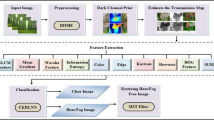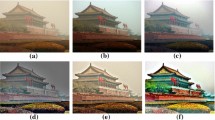Abstract
When photographs are being taken in an outdoor environment, the medium in air will cause light attenuation and further reduce image quality, and this impact is especially obvious in a hazy environment. Reduction of image quality results in the loss of information, which renders an image recognition system unable to identify objects in the image. In order to eliminate the hazy effect on images and improve the visual quality, this paper presents an efficient method combining the fuzzy inference system and the neural network filter to solve image dehazing. During dehazing, the fuzzy inference system is adopted to estimate the variations in light attenuation, and the erosion of morphological operation and the neural network filter are used to eliminate the halation and achieve optimization in transmission map refinement. Finally, the brightest 1% of the atmospheric light is utilized to calculate the color vector of atmospheric light to eliminate color cast. Experimental results indicate that the proposed method is superior to other dehazing methods.






















Similar content being viewed by others
References
Brulin D, Benezeth Y, Courtial E (2012) Posture recognition based on fuzzy logic for home monitoring of the elderly. IEEE Trans Inf Technol Biomed 16(5):974982
Kim H-H, Kim D-J, Park K-H (2012) Robust elevator button recognition in the presence of partial occlusion and clutter by specular reflections. IEEE Trans Ind Electron 59(3):1597– 1611
Walk S, Majer N, Schindler K, Schiele B (2010) New features and insights for pedestrian detection Proceeding of the 2010 IEEE conference on computer vision and pattern recognition, pp 1030–1037
McCall JC, Trivedi MM (2006) Video-based lane estimation and tracking for driver assistance: survey, system, and evaluation. IEEE Trans Intell Transp Syst 7(1):20–37
Schechner YY, Narasimhan SG, Nayar SK (2001) Instant dehazing of images using polarization Proceedings of the 2001 IEEE computer society conference on computer vision and pattern recognition, vol 1, pp 325–332
Narasimhan SG, Nayar SK (2002) Vision and the atmosphere. Int J Comput Vis 48(3):233–254
Narasimhan SG, Nayar SK (2000) Chromatic framework for vision in bad weather Proceedings of the 2000 IEEE conference on computer vision and pattern recognition, vol 1, pp 598–605
Nayar SK, Narasimhan SG (1999) Vision in bad weather Proceedings of the 1999 seventh IEEE international conference on computer vision, vol 2, pp 820–827
Shwartz S, Namer E, Schechner YY (2006) Blind haze separation Proceedings of the 2006 IEEE computer society conference on computer vision and pattern recognition (CVPR’06), vol 2, pp 1984–1991
Fattal R (2008) Single image dehazing. In: Proceedings of ACM SIGGRAPH 2008 27(3):1–8
Tan RT (2008) Visibility in bad weather from a single image Proceedings of the 2008 IEEE conference on computer vision and pattern recognition, pp 1–8
Tarel JP, Hautiere N (2009) Fast visibility restoration from a single color or gray level image Proceedings of the 2009 IEEE 12th international conference on computer vision, pp 2201– 2208
He K, Sun J, Tang X (2011) Single image haze removal using dark channel prior. IEEE Trans Pattern Anal Mach Intell 33(12):2341–2353
Kopf J, Neubert B, Chen B, Cohen M, Cohen-Or D, Deussen O, Uyttendaele M, Lischinski D (2008) Deep photo: Model-based photograph enhancement and viewing. ACM Trans Graph 27(5):1–10
Long J, Shi Z, Tang W, Zang C (2014) Single remote sensing image dehazing. IEEE Geosci Remote Sens Lett 11(1):59–63
Liu HB, Yang J, Wu ZP, Zhang QN (2015) Fast single image dehazing based on image fusion. J Electron Imaging 24(1):013020–1–013020-10
Pham DL (2001) Spatial models for fuzzy clustering. Comput Vis Image Underst 84(2):285–297
Van De Ville D, Nachtegael M, Van der Weken D, Kerre EE, Philips W, Lemahieu I (2003) Noise reduction by fuzzy image filtering. IEEE Trans Fuzzy Syst 11(4):429–436
Mendoza O, Melin P, Licea G (2009) A hybrid approach for image recognition combining type-2 fuzzy logic, modular neural networks and the Sugeno integral. Inf Sci 179(13):2078–2101
Peng DL, Wu TJ (2002) A generalized image enhancement algorithm using fuzzy sets and its application Proceedings of the 2002 IEEE conference on machine learning and cybernetics, vol 2, pp 820–823
Daugman JG (1988) Complete discrete 2-D gabor transforms by neural networks for image analysis and compression. IEEE Trans Acoust Speech Signal Process 36(7):1169–1179
Zhou Y-T, Chellappa R, Vaid A, Jenkins BK (1988) Image restoration using a neural network. IEEE Trans Acoust Speech Signal Process 36(7):1141–1151
Rowley HA, Baluja S, Kanade T (1998) Neural network-based face detection. IEEE Trans Pattern Anal Mach Intell 20(1):23–38
Kuo SC, Lin CJ, Liao JR (2011) 3D Reconstruction and face recognition using Kernel-based ICA and neural networks. Expert Syst Appl 38(5):5406–5415
Kanellopoulos I, Wilkinson GG (1997) Strategies and best practice for neural network image classification. Int J Remote Sens 18(4):711–725
Zadeh LA (1965) Fuzzy sets. Inf Control 8:338–353
Hautiere N, Tarel JP, Aubert D, Dumont É (2008) Blind contrast restoration assessment by gradient ratioing at visible edges, image anal. Stereol. 27(2):87–95
Shiau YH, Chen PY, Yang HY, Chen CH, Wang SS (2014) Weighted haze removal method with halo prevention. J Vis Commun Image Represent 25:445–453
Ge GY, Wei ZZ, Zhao JX (2015) Fast single-image dehazing using iinear transformation. Optik 126:3245–3252
Ni W, Gao X, Wang Y (2016) Single satellite image dehazing via linear intensity transformation and local property analysis. Neurocomputing 175(Part A):25–39
Author information
Authors and Affiliations
Corresponding author
Rights and permissions
About this article
Cite this article
Lin, HY., Lin, CJ. Using a hybrid of fuzzy theory and neural network filter for single image dehazing. Appl Intell 47, 1099–1114 (2017). https://doi.org/10.1007/s10489-017-0942-z
Published:
Issue Date:
DOI: https://doi.org/10.1007/s10489-017-0942-z




